
- DSL Tutorial
- DSL - Home
- DSL - Overview
- DSL - Basics
- DSL - Home
- DSL - System Components
- DSL - ADSL Fundamentals
- DSL - VDSL Access Technology
- DSL - VDSL-based Service Sets
- DSL - VDSL-based Video Service
- DSL Useful Resources
- DSL - Interview Questions
- DSL - Quick Guide
- DSL - Useful Resources
- DSL - Discussion
DSL - ADSL Fundamentals
In this chapter, we will discuss the fundamentals and standards of Asymmetric Digital Subscriber Line.
ADSL Fundamentals
To begin with, let us understand the following points.
Discrete Multi-Tone (DMT) modulation used by all ADSL standards for a physical layer.
Divide the frequency band into many small channels.
QAM modulation on each channel.
Different bits assigned to each channel in terms of SNR.
ADSL Fundamentals System Block Diagram for PHY
Following is the ADSL Fundamentals System Block Diagram for PHY.
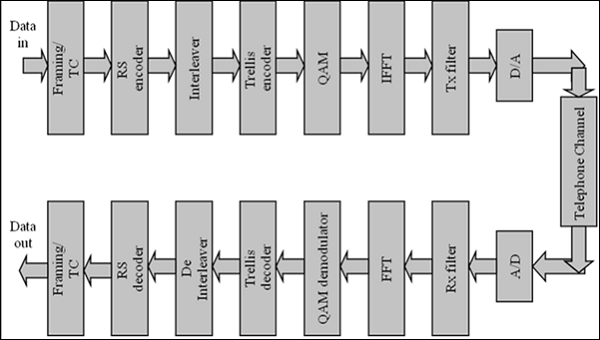
ADSL Standards
The following table describes the ADSL Standards.
| Version | Standard name | Common name | Downstream rate | Upstream rate | Approved in |
|---|---|---|---|---|---|
| ADSL | ANSI T1.4131998 Issue 2 | ADSL | 8.0 Mbit/s | 1.0 Mbit/s | 1998 |
| ADSL | ITU G.992.1 | ADSL (G.dmt) | 8.0 Mbit/s | 1.3 Mbit/s | 1999-07 |
| ADSL | ITU G.992.1 Annex A | ADSL over POTS | 12.0 Mbit/s | 1.3 Mbit/s | 2001 |
| ADSL | ITU G.992.1 Annex B | ADSL over ISDN | 12.0 Mbit/s | 1.8 Mbit/s | 2005 |
| ADSL | ITU G.992.2 | ADSL Lite (G.lite) | 1.5 Mbit/s | 0.5 Mbit/s | 1999-07 |
| ADSL2 | ITU G.992.3 | ADSL2 | 12.0 Mbit/s | 1.3 Mbit/s | 2002-07 |
| ADSL2 | ITU G.992.3 Annex J | ADSL2 | 12.0 Mbit/s | 3.5 Mbit/s | |
| ADSL2 | ITU G.992.3 Annex L | RE-ADSL2 | 5.0 Mbit/s | 0.8 Mbit/s | |
| ADSL2 | ITU G.992.4 | splitterless ADSL2 | 1.5 Mbit/s | 0.5 Mbit/s | 2002-07 |
| ADSL2+ | ITU G.992.5 | ADSL2+ | 24.0 Mbit/s | 1.4 Mbit/s | 2003-05 |
| ADSL2+ | ITU G.992.5 Annex M | ADSL2+M | 24.0 Mbit/s | 3.3 Mbit/s 2008 | 2008 |
| ADSL2++ | (up to 3.75 MHz) | ADSL4 | 52.0 Mbit/s ? | 5.0 Mbit/s | In development |
Annexure G.DMT
G.992.1 Annex A − Full rate ADSL over POTs
- Overlapped Spectrum PSD Masks
- Non-overlapped Spectrum PSD Masks
G.992.1 Annex B − Full rate ADSL over ISDN
- Overlapped Spectrum PSD Masks only, however, overlap is optional
G.992.1 Annex C − Full rate ADSL in TCM-ISDN binder
- PSD Mask as for G.992.1 Annex A
G.DMT PSDs
The following illustration describes G.DMT PSDs.
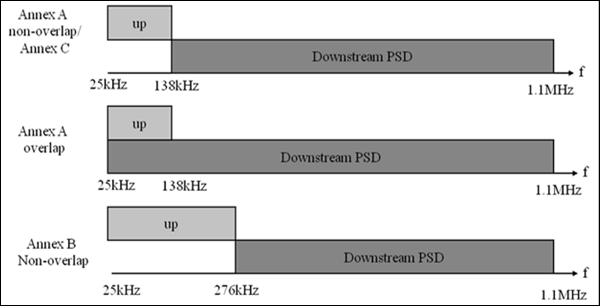
G.Dmt Performance
The G.Dmt Performance can be understood by the following description.
- NSC = number of sub carriers
- Sub carrier spacing = Δ f = 4.3125 KHz
- Data symbol rate = 4.0 KHz
- Data rate = N * 4 * 8 Kbps (multiples of 32 Kbps)
- Bandwidth = NSC * Δ f
- Sample rate = 2* NSC *Δ f
NSC 256 Total bandwidth 1.1 MHz Sample rate 2.2 MHz Maximum Date Rate ~12Mbps(down)/1.2Mbps (up) Maximum Reach 20kf
Dial Tone Services
While DMT was chosen as the official standard, systems based on the CAP have been used worldwide to implement many ADSL and a line of video sounds trials and commercial deployments, determine effectively the CAP as a de facto standard ADSL competition. Meanwhile, the threat of offering telephony services in the industry of cable television in the United States largely subsided.
Globally, the tone video applications have increased, but continues to maintain interest. In many markets, they were difficult to justify the cost in relation to the widespread availability of cable TV and satellite TV.
As a result, the video dial tone initiatives have largely disappeared in North America. The final standard for ADSL - approved by the International Telecommunication Union (ITU) (G.dmt or G.992) and ANSI (T1.413 Issue 2) – was, as mentioned earlier, a DMT-based system and is the basis of most new ADSL deployments today. Some vendors, however, continued to deploy PAC-based systems in their networks.
Application Switch from Video to Data
Throughout these long tone trial video dialing, the industry has come to recognize that many data applications were made asymmetrical. The best example of this is the internet. Typically, users send a small stream of data to a remote server, which requests the download of a data file, graphic, audio and video in particular. In response, the server starts sending the file data rate that can be supported over the network to the remote workstation. This transaction is extremely asymmetrical in nature.
During this same time, the Internet has evolved into a completely new phenomenon, which is unheard of, when compared to the rate of the new subscribers to the Internet growth services. The biggest complaint of all users is that it took too long to upload files to the modem dial or even ISDN data rates. Therefore, a new need of services and new technology were soon married, and ADSL has been reoriented to support Internet access.
Video has not completely disappeared as a request for DSL. However, video delivery over IP − using systems such as RealMedia or Windows Media – has become increasingly popular and sophisticated. Using compression systems such as MPEG-2 or new industry standard systems that allow even compression of the video, IP video delivery continues to be a viable application for DSL.
Optimization for Data Services
When the application was a bit synchronous video, the DSL line had to run at a specified line speed. However, the data can be operated at a wide range of speeds. The only effect is that slower speeds take longer to transport large files. Therefore, with data applications, we have the possibility of reducing the line speed to allow the service to be provisioned over longer lines. Both CAP and DMT transceivers have been modified to optimize the service on a loop basis and its implementation was called Adaptive Rate Digital Subscriber Line, or RADSL.
RADSL technology supports the ability to allow the transceiver to automatically-increase the line speed to the highest achievable data rate, which can be achieved reliably over a given loop. Although this feature was designed primarily to simplify the service facility, it also gives service providers the possibility of a graceful degradation of service in case of degrading loop conditions. Today, there are other DSL technologies, which support the adaptation of rates. The service providers interested in this feature should examine the extent to which it is supported in different technologies.
RADSL Standards
As it can be seen, industry and technology have changed dramatically since the tone Video ADSL standards decision in March 1993. In recognition of this Working Group, T1E1 ANSI has established a standard known as ANSI TR59 RADSL. The FCC has specifically cited RADSL as a technology that is spectrally compatible with voice and other DSL technologies in the local loop.
IDSL Provides DSL over ISDN
In some cases, DSL concepts have been applied to existing technologies. For example, ISDN DSL or IDSL, first emerged as a new spin technology of the 1980's just IDSL ISDN CPE (customer premises equipment) talking to ISDN-compatible line cards that located on the other end of the copper wire loop and terminate the ISDN signal independent of the telephone switch.
In this scenario, as with all DSL variants, the data service is directed to an extended data service, rather than of a switched network. While IDSL is based on proven technology, it is functionally an ISDN subset in that it waives any possibility to support the switched telephone service and connectivity in general. A key advantage of IDSL is the service provider seeking to move long-term ISDN data connections to Internet servers or remote LAN access off the switched network. Another key benefit is that because IDSL uses ISDN signaling methods, it is capable of transmitting over copper pairs that are served by digital loop carriers.
These devices, which are remote terminals designed to extend the reach of POTS and ISDN services beyond the usual scope of central office on completion of the copper lines, are often connected to the central office by the fiber optical private line and, as such, cannot carry any type of ADSL and SDSL DSL signals.
Multirate Symmetric DSL
Beyond the bandwidth of 144 Kbps provided by IDSL, there are new technologies that have emerged that can be better-classified office / small office and residential home (SOHO) possibilities. These technologies offer operating ranges between 128 Kbps and 2.048 Mbps.
For symmetric applications, Multirate SDSL (M / SDSL) has emerged as a valuable technology to meet the requirements of carriers to deliver Time Division Multiplex (TDM) services on an almost ubiquitous base. Based on the single pair SDSL technology, M / SDSL supports changing rate of command line transceiver and thus the operating distance of the transceiver. This version of CAP supports eight separate rates for a service 64 Kbps / 128 Kbps to 29 kft (8.9 km) 24-gauge wire (5mm) and 15 kft (4.5 km) at a speed of 2 Mbps in full. With a capacity of AutoRate (similar to RADSL), symmetric applications can now be universally deployed.
G.lite for the Consumer Market
In January 1998, the Universal ADSL Working Group (UAWG) was announced. It composed of large organizations in the telecommunications, networks and personal computers. This group was formed to develop low speed and the alternative cost of ADSL that could be installed, while the consumers were rapidly deployed by service providers. The result of the work of this group is a new subset of ADSL G.lite based standards.
G.lite was approved as a standard by the ITU (G.992.2) in June 1999 and can offer speeds up to 1.5 Mbps downstream and 512 Kbps upstream. Significantly, G.lite was designed to provide this service on existing telephone lines without the POTS splitter usually required by ADSL solutions at the full rate. A part of the G.lite, standard is as "fast retrain" known technique which limits the input power of the G.lite signal, when a telephone handset is in use. This helps to minimize interference and restore power, when the phone is back on the hook.
ReachDSL Benefits
Following are the benefits of ReachDSL.
Splitterless installation − No POTS splitter is required at the customer premises, simplifying installation and allowing customer self-installation.
Greater loop reach − In addition to ADSL systems, which can generally reach distances below 18,000 feet from the central office, the ReachDSL systems extend well beyond services 20,000 feet, with some power plants above 30,000 feet as well.
Spectral compatibility − ReachDSL solutions offer superior spectral compatibility. A member of the family ReachDSL, MVL® (multiple virtual lines), was the first DSL system recognized by the FCC in section 68 approval, which means that it is "friendly" to other services over the telephone network and not a jammer. ReachDSL also operates in spectrum management class to offer better range and higher speed.
Lower product cost − ReachDSL products utilize "off the shelf" rather than customized Digital Signal Processors (DSPs).
Dynamic bandwidth allocation − Allows the service to be customized for different applications.
VDSL Delivers Video and Higher Bandwidth
There are new variants that are emerging like – VDSL, DSL, or DSL high speed. VDSL systems are still being developed, so that the final capacity is not yet well established, but the proposed standards require downstream bandwidths up to 52 Mbps symmetrical bandwidth up to 26 Mbps. The compromise in these bandwidths is a shorter loop section, often as short as 1000 feet for higher bandwidths possible bands, with adaptation of speed at lower speeds than the length of the loop increases.
Given these limitations, VDSL deployments are planned to use a slightly different model than the traditional DSL, DSLAM with the move out of the central office of the telephone company and the neighborhood, with lines of optical fibers supplying local cabinets containing DSLAM.
The high speeds offered by VDSL bring opportunities for service providers to deliver the next generation of DSL services, with the video being considered as a first application. At 52 Mbps, a VDSL line can offer a customer complete multi-channel MPEG-2 video stream quality and even offer one or more television channels in high definition full quality (HDTV).
Some service providers have started VDSL systems deployment tests that provide these services with the endpoint VDSL appearing in the residence as a set-top box such as cable TV with an Ethernet or other data interface for connection to a PC for simultaneous data services.
The basic principle of DSL is a local loop technology in which compatible devices reside on each end of a single copper wire loop ensures that new DSL technologies continue to emerge over time. A strategic point for the service provider is to ensure that the selection of a specific technology or DSL network model for the deployment of services today will not limit options to adopt new technologies in the future.
Why ADSL2?
The following points describe why ADSL2 is so favorable
ADSL provides up to 8Mbps/800Kbps data rate (possibly 12M/1.2M).
Reach of 18-20kf 26AWG (about 6000m).
No seamless rate change.
No power saving mode when there is no user activity.
No 1-bit per bin and partial byte per symbol.
Fixed 64Kbps overhead channel rate (Framing Structure3).
ADSL2/ADSL2+
The following points describe the various features of ADSL2/ADSL2+.
ADSL2+ provides up to 24Mbps/1Mbps data rate.
Seamless rate adaptation when SNR change.
Power Management greatly reduce power consumption.
1-bit per bin and partial byte per symbol improves reach.
Reach of 20-22kf 26AWG (about 7000m).
Variable overhead channel rate meets user need.
Loop diagnostic function during training.
ADSL2/2+ Benefits
ADSL2 and ADSL2+ Delivers next generation features to improve the DSL deployment business case. Following are some of its benefits −
- Higher Rates
- Extended Reach
- Improved Stability
- Power Management
- Enhanced Spectral Compatibilit
Extended Reach
ADSL2 enables service providers to extend existing rates plans at longer loop lengths using rate enhancement technologies −
Rate Enhancement Technology −
- Reduced framing Overhead
- Mandatory Trellis Coding
- 1-bit constellations
- Data on pilot tone
Long Reach DSL (LDSL) −
- RE-ADSL2 Boosted PSD for North America
- Overlapped Mode
Framing Enhancement
The following features help in framing enhancement.
More flexible framing structure
Replaced Framing Structure types 0, 1, 2 and 3 in G.DMT
Receiver selects configuration parameters
Optimal Reed-Solomon coding possible
Configurable overhead channel from 4Kbps to 64Kbps
HDLC based OAM protocol to retrieve detailed performance monitoring information.
PMD Enhancement − Training
The following features help in PMD enhancement − training.
New line diagnostic procedures.
Receiver selects pilot tone.
Improved SNR measurement during channel analysis.
Improved exchange of detailed transmit signal characteristics.
Tone blackout to allow RFI measurement during initialization.
PMD Enhancement − Performance
The following features help in PMD enhancement − performance.
Mandatory support of trellis coding.
Mandatory support of one-bit constellation.
Data modulated on pilot tone.
Improved RFI robustness with receiver determined tone ordering.
PMD Enhancement − Power
The following features help in PMD enhancement − power.
Transmit power cutback.
Mandatory transmit power reduction.
Power saving feature for ATU-C with new L2 low power state.
Power saving feature with new L3 idle state.
PMD Enhancement – Dynamic
The following features help in PMD enhancement – dynamic.
Bit-swapping
Seamless Rate Adaptation (SRA)
Dynamic Rate Repartitioning (DDR)
WHY On-Line Reconfiguration?
The following points describe why OLR is required.
DSL line condition changes all the time crosstalk, weather, radio, environment, etc.
User activity changes all the time on/off hook, peak/normal usage.
Operator bandwidth re-allocation.
On-line Reconfiguration (OLR)
The following points tell us regarding OLR
Maintain seamless operation when line or environment are slowly changing.
Optimize rate setting (6dB margin could be reduced).
Upper layer provisioning provided.
All channels can operate independently.
Types of On-line Reconfiguration
Following are the types of OLR.
Bit Swapping (BS) −
- Relocates data and power among sub-carriers
- Adapt varying line condition
Seamless Rate Adaptation (SRA) −
- Reconfigure the total data rate
- Background SNR monitoring can find optimal setting
Dynamic Rate Repartitioning (DRR) −
- Reconfigure the data rate allocation between multiple latency paths.
Control Parameters
Following are the control parameters for Framer Configuration and PMD Function.
Framer Configuration −
Bpn − The number of octets from frame bearer #n in latency path #p.
Lp − The number of bits per symbol from latency path #p.
PMD Function −
- bi, gi
- L − Total data rate
Improved Stability with SRA
Seamless Rate Adaptation (SRA) enables the modem to change rates and bit loading to maintain a minimum per bin margin without re-training.
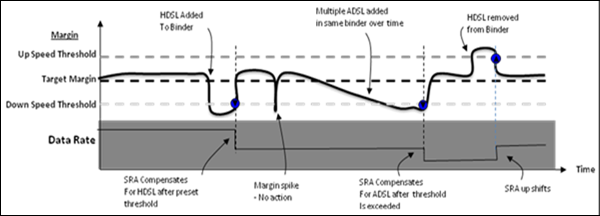
GlobespanVirata Inc.’s ADSL2 compliant SRA can change individual bins or all bins at once. It enables rate changes & noise adaptation in seconds instead of minutes.
Summary of OLR
The following table describes the summary of OLR.
| Type | Changing Parameters | Initiating | Optional | Comments |
|---|---|---|---|---|
| BS | bi, gi | Receiver | No | Changing line condition |
| DRR | bi, gi, Bpn, Lp | Receiver Transmitter |
Yes | Higher Layer |
| SRA | bi, gi, Bpn, Lp, L | Receiver Transmitter |
Yes | Higher Layer |
Power Management
The following points describe the power management in OLR
DSLAM power consumption at KW level and 24/7.
Lot of power can be saved.
Around -40 dB TX power cut back saves 100mW per port.
The 2000 port DSLAM can save 200W!
Maximum Margin Algorithm
The benefits of maximum margin algorithm of OLR are as follows −
Eliminates excess margin on the line.
Estimates line conditions and backs off Tx power during handshake.
Compatible with Legacy CPEs.
Cuts Line driver power up to 60% on typical loops.
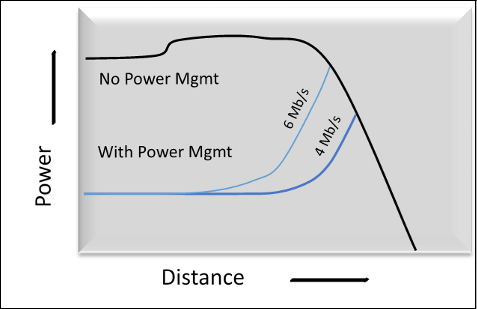
Statistical Power Management
It reduces overall power up to 50% during customer idle periods.
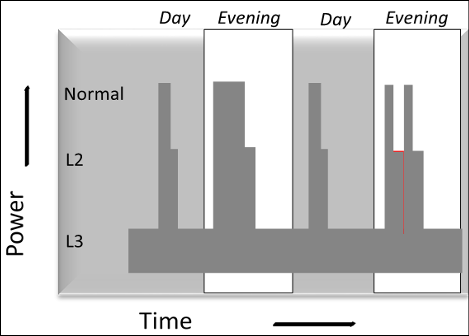
Objectives
The main objectives are Power Saving and cross-talk minimization. There are three Power Management states −
L0 − full power data mode (as we have today)
L3 − idle mode (not attempting to start)
L2 − low power mode by −
Increasing power cutback value (<40dB)
Low bit rate

Higher Rated ADSL2+ Technology
The higher rated ADSL2+ technology enables the following −
Enables higher rates for premium data, voice and video deployment.
Enables data rates up to 26 Mb/s.
Extends reach of 10-12Mb/s by up to 2x over ADSL S=1/2
Optional remote bandplan enables deployment from Remote Cabinets without degradation of services from the CO.
Individual bin disabling provides full compatibility with legacy services.
Auto-Detection of CPE capability enables compatibility with legacy CPEs

ADSL/ADSL2 ATU-C TX Spectrum
The following illustration depicts the ADSL/ADSL2 ATU-C TX Spectrum.
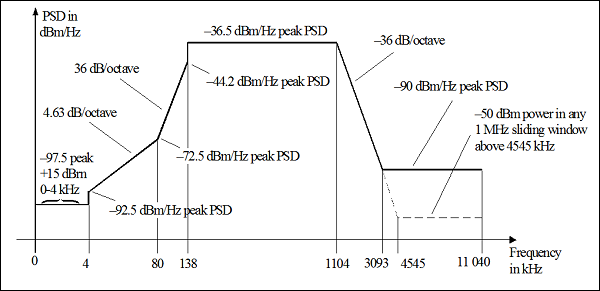
ADSL2+ ATU-C TX Spectrum
The following illustration depicts the ADSL2+ ATU-C TX Spectrum.
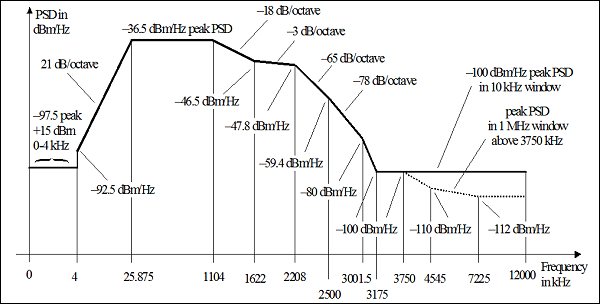
ADSL2+ Features
Following are the features of ADSL2+.
Doubles downstream spectrum from 1.1MHz to 2.2 MHz with downstream bin number increased from 256 to 512.
Maximum downstream data rate increase from 8Mbps to 24Mbps.
Improved performance at short loop length.
Wider range for SRA and Power Management from 32Kbps to 24 Mbps.
ADSL2+ Performance
The following points describe the performance of ADSL2+.
ADSL+ and ADSL2+ enable high-speed asymmetric DSL applications as well as the traditional long reach DSL services.
Auto-Detection enables fallback to ADSL2 and legacy ADSL.
ADSL2+/ G.Span enable 22/3 service without VDSL 1.5km reach limitations.
Interoperable with legacy ADSL CPEs.
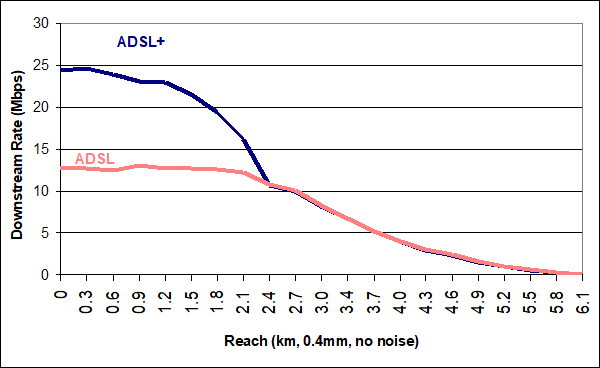
Range Extended DSL (RE-ADSL)
Range Extended ADSL (RE-ADSL) is Annex L of G.992.3
Reach extended by 1- 2 kft
The foundation of the specification has a mandatory non-overlapped PSD definition together with an optional overlapped PSD definition.
Annex M
- Introduce to improve upstream rate
- Maximally double the upstream bins
- At cost of downstream if non-overlapping
- Up to 3Mbps upstream data rate
The following table describes the various aspects of ADSL.
| ADSL 1 | ADSL2 | ADSL2+ | |||
|---|---|---|---|---|---|
| Reference | ITU G.992.1/T1.413 | ITU G.992.2.3 | ITU G.992.5 | ||
| Annexes | Annex A | Annex A | Annex L | Annex M | Annex A |
| Nickname | G.DMT | BIS | RE-ADSL | Annex M | BIS+ |
| Number of bins | 256/32 | 256/32 | 128/32 | 256/64 | 512/32 |
| Max downstream rate | 12Mbps | 12Mbps | Max reach, 22kf | ~10Mbps | 26Mbps |
| Max upstream rate | 1.2Mbps | 1.2Mbps | 3Mbps | 1.2Mpbs | |
| Advantage | early version of ADSL | QOS, Power, Reach | reach | higher upstream | higher downstream |